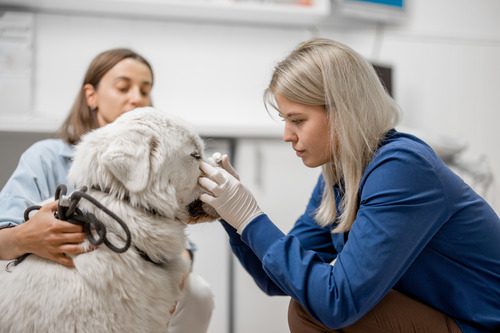Ticks are a common problem for dogs, especially during the warmer months. These tiny parasites can cause significant discomfort for your pet and pose health risks, including the transmission of diseases. In this blog, we’ll discuss how to remove a tick from your dog safely, what you need to know about ticks, and the steps to take to protect your furry friend. If you have any concerns about ticks on your dog, call South Loop Animal Hospital at (312) 753-5551 or book an appointment online!

Understanding Ticks and Their Impact on Dogs
Ticks are small, blood-sucking parasites that attach themselves to animals and humans. They are often found in grassy, wooded, or shaded areas, waiting for a host to pass by. When a tick bites, it can transmit various diseases, such as Lyme disease, Ehrlichiosis, and Anaplasmosis. These diseases can cause severe health issues for your dog if not treated promptly.
Life Stages of a Tick
Ticks go through four life stages: egg, larva, nymph, and adult. Each stage requires a blood meal to progress to the next. Understanding the life cycle of ticks can help you identify and manage them more effectively. Regular checks and prompt removal are essential to minimize the risk of tick-borne diseases.
How to Spot a Tick on Your Dog
Finding a tick on your dog can be challenging due to their small size and ability to hide in the fur. However, there are several signs that your dog might have a tick:
- Constant Scratching: If your dog is frequently scratching or biting at a particular spot, it could be a sign of a tick bite.
- Visible Ticks: During regular grooming, check for small, dark, and round bumps on your dog’s skin. Ticks often attach themselves to areas around the head, neck, ears, and feet.
- Skin Irritation: Look for signs of redness, swelling, or irritation on your dog’s skin. These can indicate a tick bite or an allergic reaction to the tick’s saliva.
- Behavioral Changes: If your dog seems unusually lethargic, loses appetite, or exhibits signs of pain, it might be suffering from a tick-borne illness.
Regularly inspecting your dog’s coat, especially after walks in grassy or wooded areas, can help you detect and remove ticks early.
Steps to Safely Remove a Tick from Your Dog
Removing a tick from your dog promptly and correctly is crucial to prevent infection and disease transmission. Follow these steps for safe tick removal:
- Prepare Your Tools: You’ll need a pair of fine-tipped tweezers, gloves, and an antiseptic. Avoid using your fingers to remove the tick, as this can increase the risk of infection.
- Wear Gloves: Put on gloves to protect yourself from potential pathogens that the tick might carry.
- Grasp the Tick: Use the tweezers to grasp the tick as close to your dog’s skin as possible. Be careful not to squeeze the tick’s body, as this can release harmful bacteria into your dog’s bloodstream.
- Pull the Tick Out: Apply steady, even pressure to pull the tick straight out. Do not twist or jerk the tick, as this can cause the mouthparts to break off and remain embedded in your dog’s skin.
- Clean the Area: Once the tick is removed, clean the bite area and your hands with antiseptic. Dispose of the tick by placing it in alcohol or flushing it down the toilet.
- Monitor Your Dog: Keep an eye on the bite area for signs of infection, such as redness, swelling, or discharge. If you notice any symptoms or your dog seems unwell, contact South Loop Animal Hospital.
What to Do After Removing a Tick
After removing a tick from your dog, it’s essential to monitor their health closely. Ticks can transmit diseases that might not show symptoms immediately. Here are some steps to take after tick removal:
Inspect the Bite Site
Check the bite site daily for signs of infection or irritation. Any redness, swelling, or oozing should be reported to your veterinarian.
Watch for Symptoms
Be vigilant for any changes in your dog’s behavior or health, such as lethargy, fever, or loss of appetite. These could be signs of a tick-borne disease.
Keep a Record
Note the date and location of the tick bite, and save the tick in a sealed container or alcohol. This can help your vet identify the type of tick and any potential diseases it may carry.
Visit the Vet
If you have any concerns or notice symptoms of illness, schedule an appointment with South Loop Animal Hospital. Early diagnosis and treatment are crucial for tick-borne diseases.
How Do You Prevent Ticks on Dogs?
Prevention is the best way to protect your dog from ticks and the diseases they carry. Here are some effective measures to prevent tick infestations:
- Apply veterinarian-recommended tick preventatives, such as topical treatments, oral medications, or tick collars. These products can help repel ticks and reduce the risk of bites.
- Regularly brush and bathe your dog to remove any ticks before they attach. Pay special attention to areas where ticks are commonly found, such as the ears, neck, and between the toes.
- Perform thorough tick checks after outdoor activities, especially if you’ve been in wooded or grassy areas. Check your dog’s entire body, including less obvious spots like the groin and under the collar.
- Keep your yard tidy by mowing the grass regularly, removing leaf litter, and trimming shrubs. Creating a tick-free zone around your home can reduce the risk of tick exposure.
- During peak tick season, try to avoid walking your dog in areas known to be infested with ticks. Stick to well-maintained trails and avoid tall grass and dense vegetation.
Understanding Tick-Borne Diseases
Ticks can transmit several serious diseases to dogs. It’s essential to be aware of the symptoms and seek veterinary care if you suspect your dog has been infected. Here are some common tick-borne diseases:
Lyme Disease
Lyme disease is caused by the bacterium Borrelia burgdorferi and is transmitted through the bite of an infected black-legged tick. Symptoms include fever, lethargy, swollen lymph nodes, and joint pain. If left untreated, Lyme disease can lead to kidney damage and other severe health issues.
Ehrlichiosis
Ehrlichiosis is caused by the bacterium Ehrlichia and is transmitted by the brown dog tick. Symptoms include fever, lethargy, weight loss, and bleeding disorders. Early diagnosis and treatment are critical to prevent long-term complications.
Anaplasmosis
Anaplasmosis is caused by the bacterium Anaplasma phagocytophilum and is transmitted by the black-legged tick. Symptoms include fever, lethargy, joint pain, and loss of appetite. Anaplasmosis can be effectively treated with antibiotics if caught early.
When to Contact Your Veterinarian
If you find a tick on your dog or notice any symptoms of tick-borne diseases, it’s essential to contact your veterinarian promptly. Early diagnosis and treatment can prevent serious health complications. South Loop Animal Hospital is here to help with any concerns you may have. Call (312) 753-5551 or book an appointment online to ensure your dog’s health and well-being.
Protecting Your Dog from Tick-Related Health Risks
Ticks are a significant concern for dog owners, but with the right knowledge and preventative measures, you can keep your pet safe. Regular tick checks, proper removal techniques, and preventive treatments are essential to protecting your dog from ticks and the diseases they carry. If you have any questions or need assistance, South Loop Animal Hospital is here to support you and your pet.







